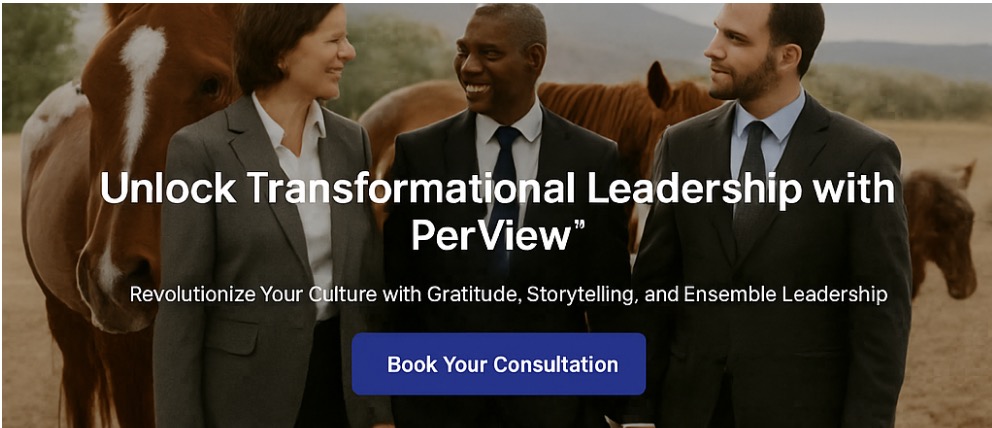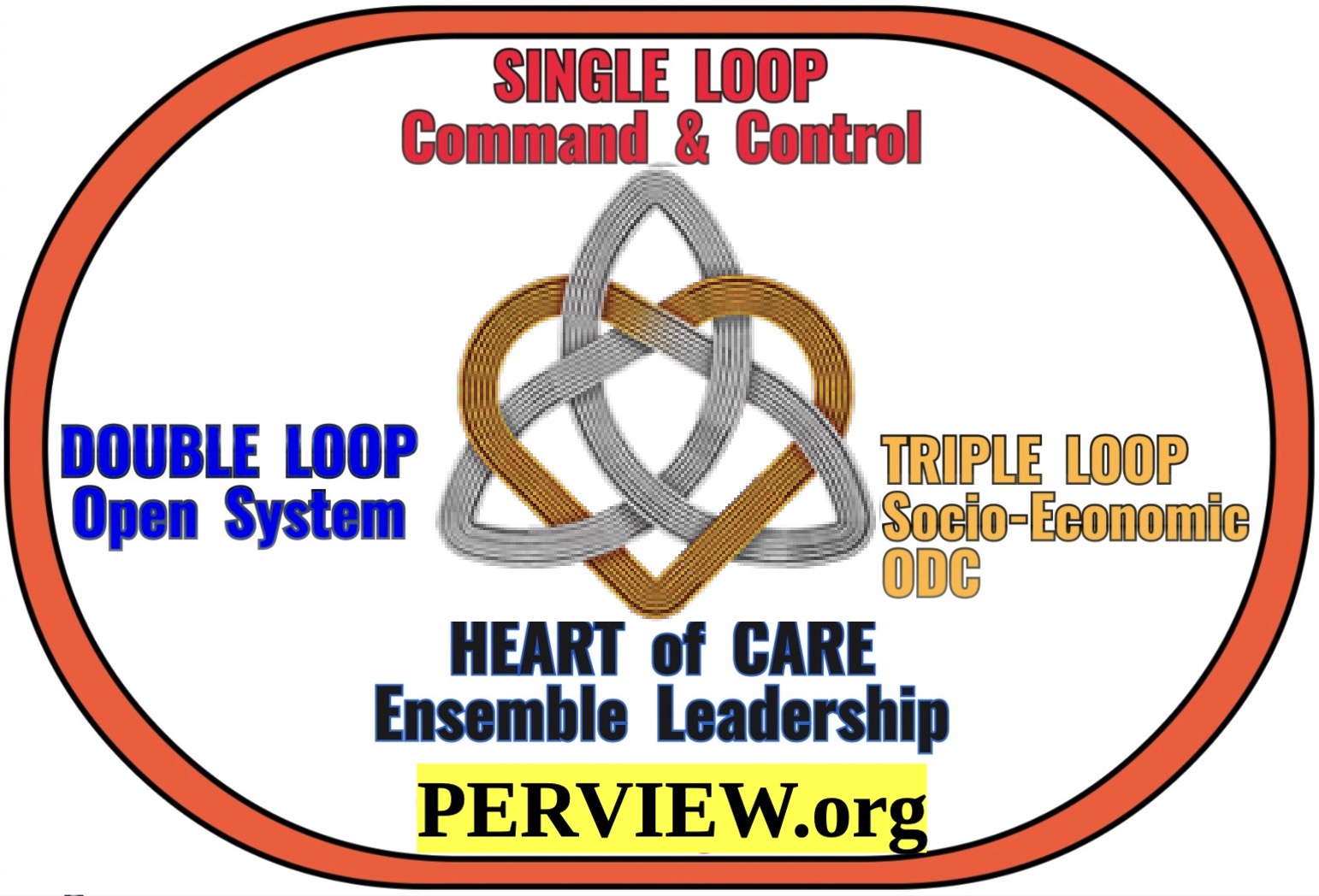Free
Guide Introduction PERVIEW
SOCIOECONOMICS DIAGNOSTIC
Tools ContactADVANCED
METHODSUSTAINABILITY DOWNLOAD
CENTER

CTA Button:
🔵 [Schedule a
Consultation]
MENU FOR THIS PAGE
✨ PerView Coaching Is
the Answer to
Intergenerational
Leadership Through ReStorying
Triple-Loop Learning Systems with
Ensemble Leadership Implementation

-
🐴 3-Day
Executive Ensemble Leadership Retreats
-
🧠 12 Monthly
Masterclasses for Implementation Follow-Up
-
🔄 Triple Loop
DPIE Teams (Diagnosis,
Project, Implementation, Evaluation) create
Revenue Generation Throughout the Year
-
💬 Ensemble
Leadership Coaching for Sustainable
Leadership & Culture Change
First, ensemble leadership theory casts leadership as
a collective phenomenon, and privileges the
collective rather than the
individual. This moves away from the ‘‘hero’’ leadership
views and
instead, connects with the
recent ‘‘relationality’’ and ‘‘shared’’ views of
leadership, breaking
new ground in collective
leadership.
Second, the ensemble leadership theory is dynamic rather than static, as revealed using storytelling
and ‘‘antenarrative’’ analysis.
Third, the ensemble leadership
theory assumes a social structure, which is decentered
as well as multi-centered and
nonhuman-centric.
Fourth, the combination of dynamism and
multi-centeredness yields a
structure which storytelling
scholars call ‘‘rhizomatic’’ and archeologists term
‘‘heterarchical.’’
These ensemble leadership theory
qualities are drawn from
indigenous cultures. In particular, archeologists have
found heterarchical leadership
structures in the prehispanic southwest portions of
North America. In sum, ensemble
leadership theory offers a time-tested model of what we
call Triple Loop Solution to Leadership Dynamics
It is helpful to note that the
Triple Loop Ensemble Leadership is associated with
ensemble is not merely multiple
hierarchies, nor is it lack of all hierarchy. Rather, in
our view, it is the shape-shifting
ability of the Triple Loop
Ensemble Leadership System to morph into hierarchy or
into flatter more egalitarian models.
Ensemble does this not by moving around the blocks on
the organization chart, but rather, by not being composed of blocks in the first
place. Further, our sense of heterarchy is not based on a linear or sequential understanding
of multiple hierarchies in different times and
places. Rather, Triple Loop Ensemble
Leadership for us indicates the ability to fluidly shift
among types of hierarchies, most
but not all of them more egalitarian.
Rosile, Grace Ann; Boje, David
M; Claw, C. M. (2018). Ensemble leadership
theory: Collectivist, relational, and heterarchical
roots from indigenous contexts. Leadership, 14(3), 307-328. See
this Ground breaking article
In The Triple
Loop Mystery, David Boje and
Grace Ann Rosile delve into a longstanding
enigma in organizational theory: the nature
and application of "Triple Loop
Learning." Building upon Kenneth
Boulding's 1956 hierarchical systems theory,
they propose a transformative framework
called Conversational Storytelling Inquiry
(CSI). This approach integrates
insights from quantum physics, indigenous
knowledge systems, and the Socio-Economic
Approach to Management (SEAM) to redefine
organizational learning and leadership.See PDF
The Evolution of
Learning Loops
Single-Loop
Learning (Cybernetic Command-And-Control
System):
-
Focuses on
error correction without altering
underlying values or policies.
-
Analogous to
a thermostat adjusting temperature
settings.
-
Emphasizes
"doing things right."David
Boje
Double-Loop
Learning (Open System):
Triple-Loop
Ensemble Leadership System (Continuing
Socio-Economic Organizational Transformation
and Development)
The D-P-I-E
Cycles of Interlocking Team interventions Across
the Corporation to bring about Untapped Revenue
Potential, Lower Costs, and Increase
Productivity

Each Team does repeating cycles of intervention,
and when complete disbands, as new teams are
composed. The Ensemble Leadership Approach combine
with PERVIEW Coaching keeps the momentum building
for optimal results.

DPIE
Cascading Teams for Productivity and Potential Revenue
Development
-
Diagnosis: Identifying
dysfunctions within the organization.
-
Project
Planning: Developing
strategies to address identified
issues.
-
Implementation: Executing
planned interventions.
-
Evaluation: Assessing
outcomes to inform future actions.
This approach
aims to optimize human potential and
improve economic performance by aligning
organizational structures with
socio-economic realities.
🔄
ROI from Triple Loop
DPIE Teams (Per Team, Annually)
|
Metric
|
Amount (USD)
|
|
⏱️ Team Cost (6 hrs/week)
|
$43,269
|
|
💰 4x ROI Generated
|
$173,077
|
|
💰 5x ROI Generated
|
$216,346
|
|
✅ Net Benefit
|
$129,808 – $173,077
|
Multiply by 10 teams
= $1.3M–$1.7M in net
value creation annually
📊 Annual Investment:
Full PerView System
|
Program Element
|
Annual Cost
|
|
|
🐴 Executive Retreat
|
$105,000
|
|
|
🧠 12 Webinars
|
Included
|
|
|
🔄 10 DPIE Teams (Staff Time)
|
$432,692
|
|
|
💼 Total Investment
|
$537,692
|
|
|
ROI Estimate
|
Value Generated
|
Net Financial
Gain
|
|
4x ROI
|
$1,730,769
|
$1,193,077
|
|
5x ROI
|
$2,163,461
|
$1,625,769
|
📈 Cost Comparison of
The PerView Advantage
|
Conventional
Approach
|
PerView System
|
|
High-cost turnover and retraining
|
Deep-rooted retention and morale
|
|
Disconnected leadership programs
|
Integrated, story-driven coaching
|
|
Reactive project management
|
DPIE: proactive, team-led innovation
|
|
Burnout and disengagement
|
Ensemble Leadership & cultural
reset
|
🔵 [Schedule a
Consultation]
or call us at (575) 926-9578
📬 Let’s build your
next-level leadership culture.